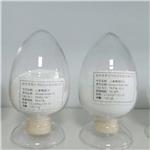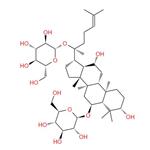- Ginsenoside Rg1
-

- $0.00 / 1g
-
2025-04-25
- CAS:22427-39-0
- Min. Order: 1g
- Purity: 50%-98% HPLC
- Supply Ability: 100kg
- Ginsenoside Rg1
-

- $0.00 / 1g
-
2025-04-25
- CAS:22427-39-0
- Min. Order: 1g
- Purity: ≥98% HPLC
- Supply Ability: 1000kg
- Ginsenoside Rg1
-

- $990.00 / 1kg
-
2025-04-23
- CAS:22427-39-0
- Min. Order: 1kg
- Purity: 99%
- Supply Ability: 5000
|
| | Ginsenoside Rg1 Basic information |
| | Ginsenoside Rg1 Chemical Properties |
| Melting point | 194~197℃ | | Boiling point | 898.5±65.0 °C(Predicted) | | density | 1.33±0.1 g/cm3(Predicted) | | storage temp. | Sealed in dry,Store in freezer, under -20°C | | solubility | DMSO (Slightly), Methanol (Slightly), Pyridine (Slightly) | | pka | 12.91±0.70(Predicted) | | form | Solid | | color | White to Off-White | | biological source | Panax notoginseng (Burk.) F.H.Chen | | Stability: | Hygroscopic | | InChIKey | YURJSTAIMNSZAE-OLCOBRLXNA-N | | LogP | 1.670 (est) | | CAS DataBase Reference | 22427-39-0(CAS DataBase Reference) |
| | Ginsenoside Rg1 Usage And Synthesis |
| Description |
Ginsenoside RG1(Rg1) is a natural product found in Panax notoginseng, Panax ginseng, and Panax vietnamensis. It is one of the primary bioactive ingredients in Panax notoginseng saponins. Numerous studies have indicated that Rg1 plays significant roles in health benefits such as anticancer, neuroprotective, anti-senescence, anti-inflammation, and antioxidative effects. Also, extensive research has demonstrated that Rg1 is associated with various diseases, including cardiovascular disease, Alzheimer’s disease, spinal cord injury, and liver injury. Xue et al. and Yu et al. demonstrated that Rg1 ameliorated streptozotocin-induced oxidative stress and myocardial apoptosis and suppressed HG-induced mesenchymal activation and fibrosis[1].
| | Chemical Properties | White solid | | Uses | Ginsenoside Rg1 protects against arthitis through osteoclast differentiation inhibition. Anti-tumor agent, inhibits the NF-kB-dependant MMP-expression in PMA (phorbol myristate acetate)-induced tumor cell invasion. | | Definition | ChEBI: A ginsenoside found in Panax ginseng and Panax japonicus var. major that is dammarane which is substituted by hydroxy groups at the 3beta, 6alpha, 12beta and 20 <ital pro-S positions, in which the hydroxy groups at positions 6 and 20 have been converted to the corresponding beta-D-glucopyranosides, and in which a double bond has been introduced at the 24-25 posit on. | | in vivo | In the inflamed joints of adjuvant-induced arthritis (AIA) rats, the level of p-IκBα and p-p65 is significantly higher than in controls and PPAR-γ levels are significantly lower. Treatment with Ginsenoside Rg1 in vivo inhibits IκBα phosphorylation, reduces NF-κB nuclear translocation and upregulates PPAR-γ expression[2]. Ginsenoside Rg1 (G-Rg1) and Ginsenoside Rg2 (G-Rg2) reduce the escape latencies on the last two training days compared to the Alzheimer's disease (AD) model group (p<0.05). In the spatial exploration test, the total time spent in the target quadrant and the number of mice that exactly crossed the previous position of the platform are clearly shorter and lower, respectively, in the AD model group mice than in the normal control group mice (p<0.01), a trend that is reversed by treatment with Ginsenoside Rg1 and Ginsenoside Rg2 (Ginsenoside Rg1, p<0.01; Ginsenoside Rg2, p<0.05). Treatment with Ginsenoside Rg1 and Ginsenoside Rg2 effectively improve cognitive function of the mice that have declined due to AD. Ginsenoside Rg1 and Ginsenoside Rg2 reduce Aβ1-42 accumulation in APP/PS1 mice. In the Ginsenoside Rg1 and Ginsenoside Rg2 treated mice, the pathological abnormalities observed in the APP/PS1 mice are gradually ameliorated. Clear nucleoli and light brown, sparsely scattered Aβ deposits are visible[1]. | | IC 50 | Aβ1-42; p65 | | References | [1] Hui Liu. “Ginsenoside Rg1 attenuates the inflammation and oxidative stress induced by diabetic nephropathy through regulating the PI3K/AKT/FOXO3 pathway.” Annals of translational medicine 9 24 (2021): 1789. |
| | Ginsenoside Rg1 Preparation Products And Raw materials |
|